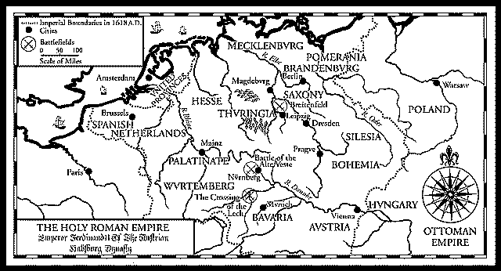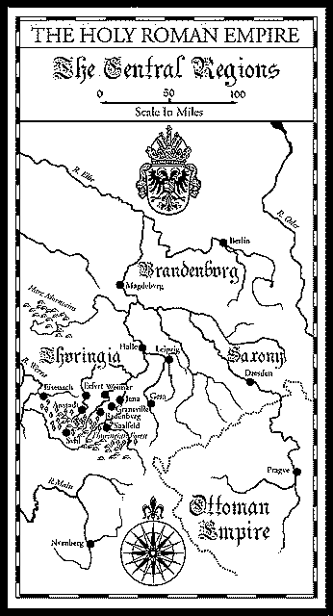1632
Authors: Eric Flint


 1632
1632Table of Contents
PROLOGUE1632
PART ONEChapter 1PART TWO
Chapter 2
Chapter 3
Chapter 4
Chapter 5
Chapter 6
Chapter 7
Chapter 8
Chapter 9
Chapter 10
Chapter 11
Chapter 12
Chapter 13
Chapter 14Chapter 15PART THREE
Chapter 16
Chapter 17
Chapter 18
Chapter 19
Chapter 20
Chapter 21
Chapter 22
Chapter 23
Chapter 24
Chapter 25
Chapter 26
Chapter 27
Chapter 28
Chapter 29
Chapter 30
Chapter 31
Chapter 32
Chapter 33Chapter 34PART FOUR
Chapter 35
Chapter 36Chapter 37PART FIVE
Chapter 38
Chapter 39
Chapter 40
Chapter 41
Chapter 42
Chapter 43
Chapter 44Chapter 45PART SIX
Chapter 46
Chapter 47
Chapter 48Chapter 49PART SEVEN
Chapter 50
Chapter 51
Chapter 52
Chapter 53
Chapter 54
Chapter 55
Chapter 56
Chapter 57
Chapter 58Chapter 59
Chapter 60
Chapter 61
Author’s Afterword
The Ultimate Y2K Glitch....
1632 In the year 1632 in northern
Germany a reasonable person might conclude that things couldn’t get much
worse. There was no food. Disease was rampant. For over a decade religious
war had ravaged the land and the people. Catholic and Protestant armies
marched and countermarched across the northern plains, laying waste the
cities and slaughtering everywhere. In many rural areas population
plummeted toward zero. Only the aristocrats remained relatively unscathed;
for the peasants, death was a mercy.
2000 Things are going OK in
Grantville, West Virginia. The mines are working, the buck are plentiful
(it’s deer season) and everybody attending the wedding of Mike Stearn’s
sister (including the entire membership of the local chapter of the United
Mine Workers of America, which Mike leads) is having a good time.
When the dust settles, Mike leads a small group of armed
miners to find out what’s going on. Out past the edge of town Grantville’s
asphalt road is cut, as with a sword. On the other side, a scene out of
Hell; a man nailed to a farmhouse door, his wife and daughter Iying
screaming in muck at the center of a ring of attentive men in steel vests.
Faced with this, Mike and his friends don’t have to ask who to shoot.
At that moment Freedom and Justice, American style, are
introduced to the middle of The Thirty Years War.
Cover Art by Larry Elmore
Interior maps by Randy Asplund
Hardcover
PaperbackThis is a work of fiction. All the characters and events portrayed in this book are fictional, and any resemblance to real people or incidents is purely coincidental.
First printing, February 2000
Distributed by Simon & Schuster
1230 Avenue of the Americas
New York, NY 10020Library of Congress Cataloging-in-Publication Data
Flint, Eric.
1632 / by Eric Flint.
p. cm.
ISBN 0-671-57849-9 (hc)
1. Thirty Years’ War, 1618–1648—Fiction. 2. City and town life—West Virginia—Fiction. 3. Germany—History—1618–1648—Fiction.
4. Americans—Travel—Germany—Fiction. 5. West Virginia—Fiction. 6. Time travel—Fiction. I. Title.
PS3556.L548 A616 2000
813’.54—dc21 99-055275Typeset by Windhaven Press, Auburn, NH
Printed in the United States of AmericaISBN-13: 978-0-671-57849-7
ISBN-10: 0-671-57849-9Copyright© 2000 by Eric Flint
All rights reserved, including the right to reproduce this book or portions thereof in any form.
A Baen Books Original
Baen publishing Enterprises
P.O. Box 1403
Riverdale, NY 10471
http://www.baen.comElectronic version by WebWrights
http://www.webscription.net
To my mother,Prologue
Mary Jeanne McCormick Flint,
and to the West Virginia
from which she came.Baen Books by Eric Flint
Mother of Demons
The Belisarius series, with David Drake:
An Oblique Approach
In the Heart of Darkness
Destiny’s Shield
The mystery would never be solved. It would simply join others, like the Tunguska event or the Square Crater on Callisto, in the catalogue of unexplained occurrences. The initial worldwide excitement waned within a few months, as it became clear that no quick answers would be found. For a few years grieving relatives would, with some success, press officialdom to maintain the studies and inquiries. But there were no lawyers to keep the fires stoked. The courts ruled soon enough that the Grantville Disaster was an Act of God, for which insurance companies were not liable. Within ten years, the Disaster had devolved into another domain of fanatics and enthusiasts, like the Kennedy Assassination. Thereafter, of course, it enjoyed a near-eternal half-life. But few if any reputable scientists in the world held out any hope for a final explanation.
Theories, of course, abounded. But the vague traces on instruments were impossible to decipher clearly. A small black hole, passing through the Earth. That was one theory. Another—popular for a time until the underlying mathematics were rejected in the light of later discoveries—was that a fragmented superstring had struck the planet a glancing blow.
The only man who ever came close to understanding that a new universe had been created was a biologist. A junior biologist by the name of Hank Tapper, attached almost as an afterthought to one of the geological teams sent to study the disaster. The team devoted several months to a study of the terrain which had replaced what had once been part of West Virginia. They came to no conclusions other than the obvious fact that the terrain was not indigenous to the area, but that—this eliminated the once-avid interest of the SETI crowd—it was clearly terrestrial.
The size of the foreign terrain was mapped, quite precisely. It formed a perfectly circular hemisphere about six miles in diameter, approximately half that deep at its center. Once the team left, Tapper remained behind for a few more months. Eventually, he identified the fauna and flora as being almost identical to those of parts of Central Europe. He became excited. That matched the archaeological report, which—very, very diffidently—suggested that the ruined farmhouses on the new terrain had a vaguely late-medieval/early modern Germanic feel to them. So did the seven human corpses found in one of the farmhouses. Two men, two women, and three children. The remains were badly charred by the fire, but marks on the bones indicated that at least two of the people had been murdered by some kind of large cutting implements.
The dental evidence suggested that the dead people were not modern. Or, at least, had somehow never been given any kind of dental treatment. But medical examination determined that the murders were very recent. And the farmhouses were still smoldering when they were found.
Tapper teetered on the edge of the truth. Then, after several more months of work failed to turn up any matching piece of disturbed terrain anywhere in central Europe, he abandoned the study altogether. He had suspicions, but—
The only possible explanation was a transposition in time as well as space. Tapper was a junior biologist. His budding career would be ruined if he advanced his suspicions without evidence. And there could be no evidence, if he was right. Whatever remained of the area of West Virginia which had vanished was lost somewhere back in time.
So, Tapper accepted the loss of a year’s work, and went in search of greener pastures. He published his findings, to be sure; but only as dry factual accounts in obscure publications. He made no attempt to draw conclusions, or posit theories, or draw any kind of public attention.
It was just as well. His career would have been ruined—and for no good purpose. No one would have believed him. Even if someone had, the most extensive archaeological search of central Europe would never have discovered the matching hemisphere. It was there, of course, in that region of Germany called Thuringia. But it was there almost four centuries earlier, and only for an instant. The moment those hemispheres had been transposed, a new universe split off from the old.
And, besides, the truth was far stranger than even Tapper ever imagined. Even he assumed that the cause was some kind of natural cosmic disaster.
In reality, the Grantville Disaster was the result of what humans of the day would have called criminal negligence. Caused by a shard of cosmic garbage, a discarded fragment of what, for lack of a better term, could be called a work of art. A shaving, you might say, from a sculpture. The Assiti fancied their solipsist amusements with the fabric of spacetime. They were quite oblivious to the impact of their “art” on the rest of the universe.
The Assiti would be exterminated, eighty-five million years later, by the Fta Tei. Ironically, the Fta Tei were a collateral branch of one of the human race’s multitude of descendant species. Their motive, however, was not revenge. The Fta Tei knew nothing of their origins on a distant planet once called Earth, much less a minor disaster which had occurred there. The Fta Tei exterminated the Assiti simply because, after many stern warnings, they persisted in practicing their dangerous and irresponsible art.
Tiger! Tiger! burning bright
In the forests of the night

